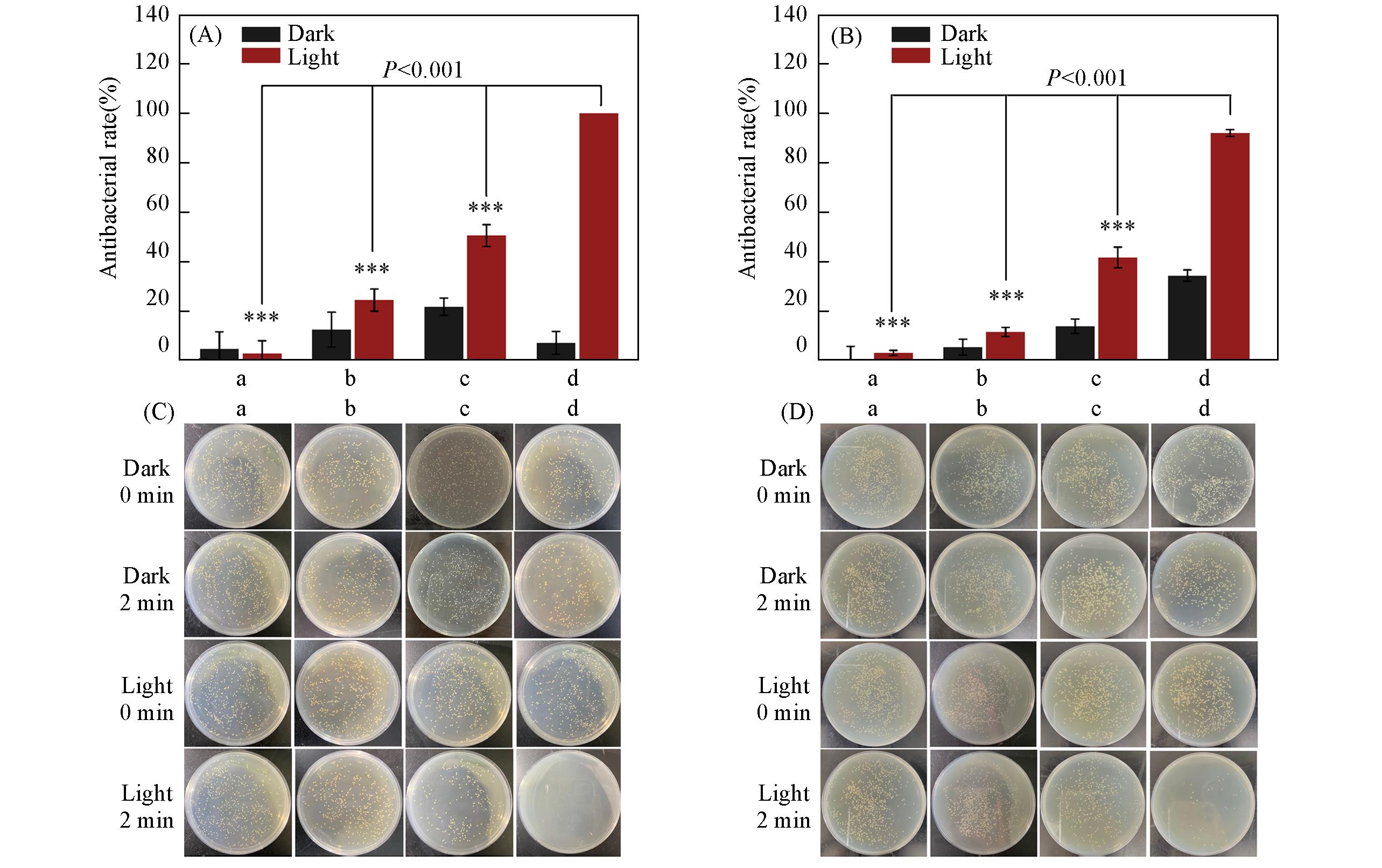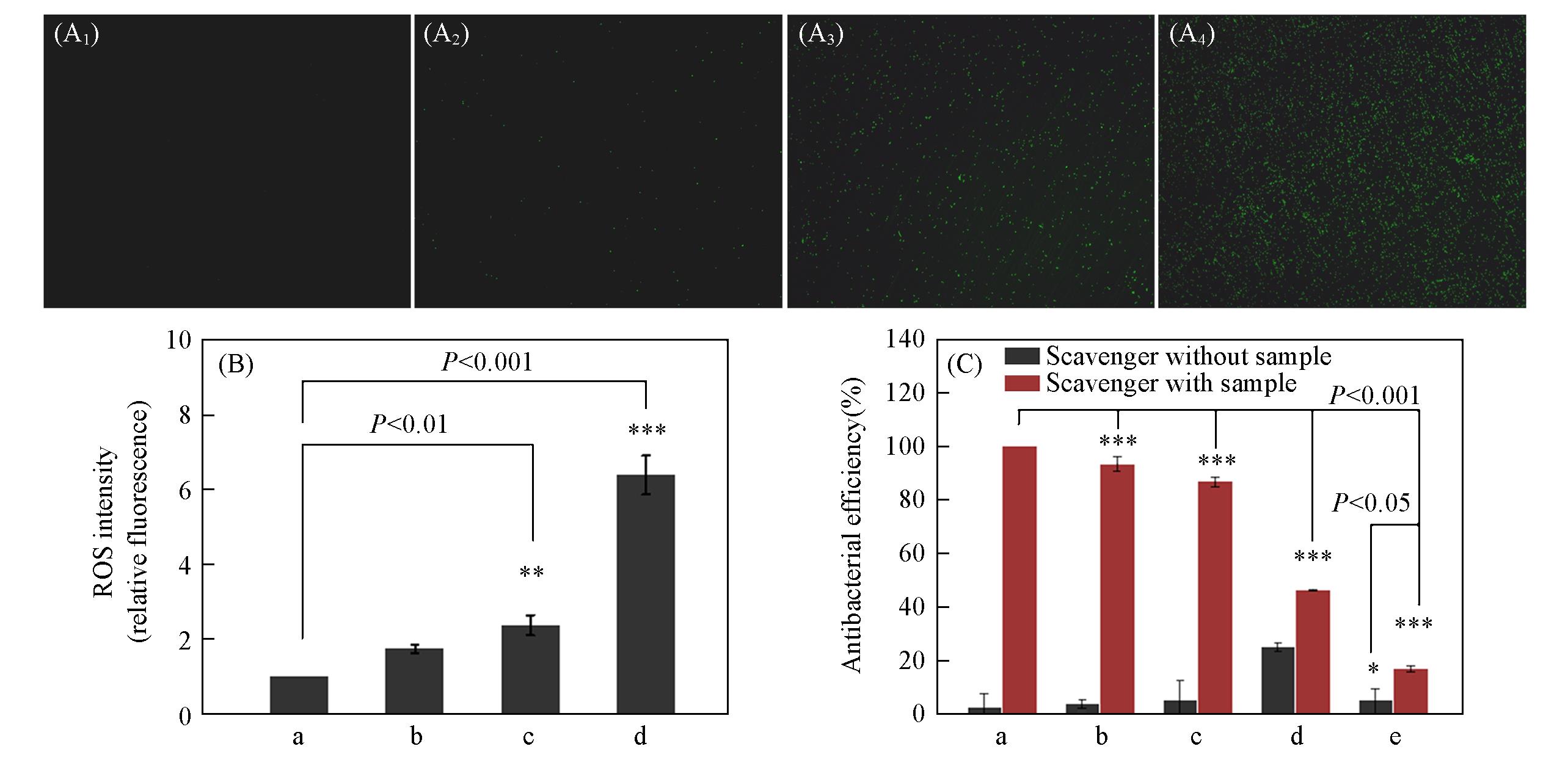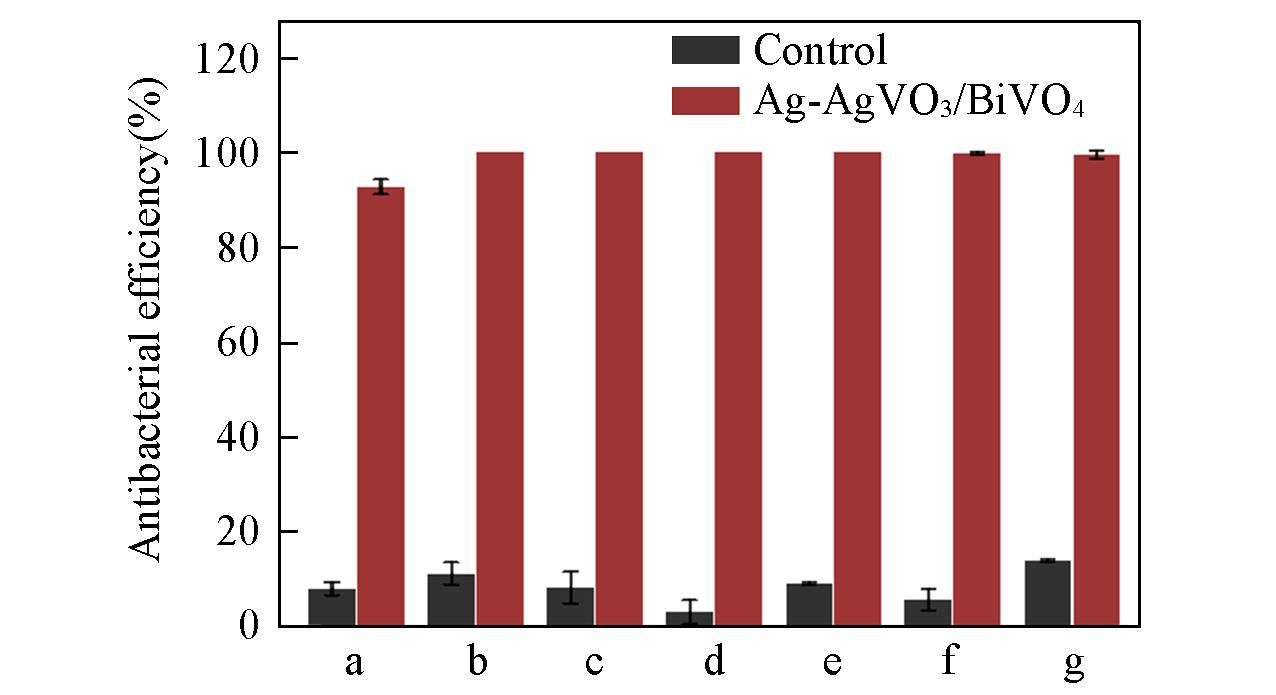

高等学校化学学报 ›› 2022, Vol. 43 ›› Issue (10): 20220132.doi: 10.7503/cjcu20220132
邵文惠1, 胡欣1, 尚静1, 林峰3, 金黎明1, 权春善1, 张艳梅1( ), 李军2
), 李军2
收稿日期:2022-03-03
出版日期:2022-10-10
发布日期:2022-06-17
通讯作者:
张艳梅
E-mail:ymzhang@dlnu.edu.cn
基金资助:
SHAO Wenhui1, HU Xin1, SHANG Jing1, LIN Feng3, JIN Liming1, QUAN Chunshan1, ZHANG Yanmei1( ), LI Jun2
), LI Jun2
Received:2022-03-03
Online:2022-10-10
Published:2022-06-17
Contact:
ZHANG Yanmei
E-mail:ymzhang@dlnu.edu.cn
Supported by:摘要:
合成了一种具有树叶状形貌的Ag-AgVO3/BiVO4复合光催化抗菌剂, 并对其晶体结构、 形貌、 组成及光学性质等进行了表征. 研究结果表明, 以3,3',5,5'-四甲基联苯胺(TMB)的氧化反应为模型, Ag-AgVO3/BiVO4表现出优异的光响应类氧化酶活性. 光催化抗菌实验结果表明, Ag-AgVO3/BiVO4对金黄色葡萄球菌和大肠杆菌均具有良好的抗菌效果, 4 min内的抗菌效率可以达到99%以上. 采用多种实验方法系统研究了其抗菌机制: 活性物种捕获剂实验和细胞内活性氧荧光标记实验表明, 在可见光照射下, Ag-AgVO3/BiVO4所产生的电子与O2反应生成的·O2?起主要作用; Live/Dead细胞的荧光实验、 扫描电子显微镜形貌观察实验以及处理前后细胞内外核酸和蛋白质含量的测定实验结果均证实了·O2?可以破坏细胞膜的完整性, 导致细胞内容物的破坏和流出, 从而造成细菌死亡. 另外, Ag-AgVO3/BiVO4对包括革兰氏阳性菌、 革兰氏阴性菌和真菌在内的9种致病菌均具有良好的抗菌效果, 说明其具有广谱抗菌性能.
中图分类号:
TrendMD:
邵文惠, 胡欣, 尚静, 林峰, 金黎明, 权春善, 张艳梅, 李军. 高效广谱复合光催化抗菌剂Ag-AgVO3/BiVO4的设计合成及抗菌机制. 高等学校化学学报, 2022, 43(10): 20220132.
SHAO Wenhui, HU Xin, SHANG Jing, LIN Feng, JIN Liming, QUAN Chunshan, ZHANG Yanmei, LI Jun. Design, Synthesis and Photocatalytic Antibacterial Mechanism of Ag-AgVO3/BiVO4 Composite as a High-efficient and Broad-spectral Antibacterial Agent. Chem. J. Chinese Universities, 2022, 43(10): 20220132.

Fig.4 Oxidase?like activity(A), steady?state kinetic assays of photocatalytic activity for Ag?AgVO3/BiVO4(B) and the corresponding double reciprocal plots of TMB(C)

Fig.6 Photocatalytic antibacterial rate for different photocatalysts in dark and irradiated by visible light for 2 min(A, B) and corresponding spread plate results of S. aureus and E. coli grown on different samples(C, D)(A, C) S. aureus; (B, D) E.coli. a. Control; b. BiVO4; c. Ag-AgVO3; d. Ag-AgVO3/BiVO4.

Fig.7 Fluorescence images(A1—A4) and ROS intensities(B) of bacterial cells treated with different materials and antibacterial activity of Ag?AgVO3/BiVO4 in the absence(control) or presence of different scavengers against S.aureus(C)(A1) Control, (A2) BiVO4, (A3) Ag-AgVO3, (A4) Ag-AgVO3/BiVO4; (B) a. control, b. BiVO4, c. Ag-AgVO3, d. Ag-AgVO3/BiVO4; (C) a. no scavenger, b. IPA(·OH), c. triethanolamine(h+), d. 1,4-benzoquinone(·O2- ), e. K2CrO7(e-).

Fig.8 Representative fluorescence images of live(blue) and dead(red) cells after treatment(A) Control-S.aureus; (B) AgVO3/BiVO4-light-S.aureus; (C) control-E.coli; (D) AgVO3/BiVO4-light-E.coli.

Fig.9 SEM images of bacterial in different pretreated conditions(A) Blank-S.aureus; (B) Blank-E.coli; (C) Ag-AgVO3/BiVO4-light-S. aureus; (D) Ag-AgVO3/BiVO4-light-E. coli.

Fig.11 Antibacterial properties of Ag?AgVO3/BiVO4 against seven common pathogensa. S. typhimurium; b. V. parahemolyticus; c. P. aeruginosa; d. K. pneumoniae; e. A. baumannii; f. E. faecalis; g. C. albicans.
| 1 | Ibrahim U. H., Devnarain N., Govender T., Int. J. Pharm., 2021, 596, 120267 |
| 2 | Xu M. J., Li L., Hu Q. L., Biomater. Sci., 2021, 9(6), 1995—2008 |
| 3 | Cano A., Ettcheto M., Espina M., Lopez⁃Machado A., Cajal Y., Rabanal F., Sanchez⁃Lopez E., Camins A., Garcia M. L., Souto E. B., J. Nanobiotechnol., 2020, 18(1), 156 |
| 4 | Smerkova K., Dolezelikova K., Bozdechova L., Heger Z., Zurek L., Adam V., Wiley Interdiscip. Rev. Nanomed. Nanobiotechnol., 2020, 12(5), e1636 |
| 5 | Xie W.J., Zhang S., Pan F. W., Chen S., Zhong L. N., Wang J., Pei X. B., J. Mater. Res., 2021, 36(4), 822—845 |
| 6 | Byrne J. A., Dunlop P. S. M., Hamilton J. W. J., Fernandez⁃Ibanez P., Polo⁃Lopez I., Sharma P. K., Vennard A. S. M., Molecules, 2015, 20(4), 5574—5615 |
| 7 | Dalrymple O. K., Stefanakos E., Trotz M. A., Goswami D. Y., Appl. Catal., B, 2010, 98(1/2), 27—38 |
| 8 | Daub N. A., Aziz F., Aziz M., Jaafar J., Salleh W. N. W., Yusof N., Ismail A. F., Water Air Soil Pollut., 2020, 231(9), 461 |
| 9 | Gamage J., Zhang Z. S., Int. J. Photoenergy, 2010, 2010(2010), 1—11 |
| 10 | Murugesan P., Moses J. A., Anandharamakrishnan C., J. Mater. Sci., 2019, 54(19), 12206—12235 |
| 11 | Wang W. J., Huang G. C., Yu J. C., Wong P. K., J. Environ. Sci., 2015, 34(008), 232—247 |
| 12 | Yu H. T., Chen S., Quan X., Zhang Z. H., Progress in Chemistry, 2017, 29(9), 1030—1041 |
| 13 | Zhang C., Li Y., Shuai D. M., Shen Y., Wang D. W., Chem. Eng. J., 2019, 355, 399—415 |
| 14 | Kumar R., Raizada P., Verma N., Hosseini⁃Bandegharaei A., Thakur V. K., Le Q. V., Nguyen V. H., Selvasembian R., Singh P., J. Cleaner Prod., 2021, 297, 126617 |
| 15 | Nayak R., Ali F. A., Mishra D. K., Nanda B., Mater. Res. Bull., 2021, 144, 111510 |
| 16 | Shan L. W., Lu C. H., Dong L. M., Suriyaprakash J., J. Alloys Compd., 2019, 804, 385—391 |
| 17 | Wang P., Zheng J. Y., Zhang D., Kang Y. S., New J. Chem., 2015, 39(12), 9918—9925 |
| 18 | Li D., Liu Y., Shi W. W., Shao C. Y., Wang S. Y., Ding C. M., Liu T. F., Fan F. T., Shi J. Y., Li C., ACS Energy Lett., 2019, 4(4), 825—831 |
| 19 | Li R. G., Han H. X., Zhang F. X., Wang D. G., Li C., Energy Environ. Sci., 2014, 7(4), 1369—1376 |
| 20 | Li R. G., Zhang F. X., Wang D. G., Yang J. X., Li M. R., Zhu J., Zhou X., Han H. X., Li C., Nat. Commun., 2013, 4(2), 1432 |
| 21 | Liu T. F., Zhao Q. Y., Li C., Lyu Y., Dupuis M., J. Phys. Chem. C, 2019, 123(33), 20142—20151 |
| 22 | Qi Y., Zhang J. W., Kong Y., Zhao Y., Chen S. S., Li D., Liu W., Chen Y. F., Xie T. F., Cui J. Y., Nat. Commun., 2022, 13(1), 484 |
| 23 | Yuan B., Chong R. F., Zhang B., Li J., Liu Y., Li C., Chem. Commun., 2014, 50(98), 15593—15596 |
| 24 | He Z. Q., Shi Y. Q., Gao C., Wen L. N., Chen J. M., Song S., J. Phys. Chem. C, 2014, 118(1), 389—398 |
| 25 | Meng S. P., Ogawa T., Okumura H., Ishihara K. N., Catalysts, 2020, 10(11), 1294 |
| 26 | Mohamed N. A., Safaei J., Ismail A. F., Khalid M. N., Jailani M. F. A. M. ,Noh M. F. M., Arzaee N. A., Zhou D., Sagu J. S., Teridi M. A. M., Mater. Res. Bull., 2020, 125, 110779 |
| 27 | Wu X. B., Zhou H. L., Gu S. N., Wang F. Z., Liu J., Li W. J., RSC Adv., 2015, 5(112), 92769—92777 |
| 28 | Xu X. L., Song W., Mater. Technol., 2017, 32(8), 472—479 |
| 29 | Li Y., Liao D., Li T. Y., Zhong W., Wang X. F., Hong X. F., Yu H. G., J. Colloid Interface Sci., 2020, 570, 232—241 |
| 30 | Guo J. Y., Liang J., Yuan X. Z., Jiang L. B, Zeng G. M, Yu H. B., Zhang J., Chem. Eng. J., 2018, 352, 782—802 |
| 31 | Holtz R. D., Lima B. A., Souza A. G., Brocchi M., Alves O. L., Nanomed. Nanotechnol. Biol. Med., 2012, 8(6), 935—940 |
| 32 | Klockner W., Vidal C. P., de Dicastillo C. L., Yadav R. M., Singh D. P., Mater. Lett., 2020, 278, 128403 |
| 33 | Liu B. K., Mu L. L., Han X. L., Zhang J. T., Shi H. Z., J. Photochem. Photobiol., 2019, 380, 111866 |
| 34 | Wang Q. Q., Zhou X. Q., Ji S. T., Li S. Y., Gu J. Z., Shen L. X., Liu P., Yin J. H., Xu G., Shi W. Y., J. Environ. Chem. Eng., 2021, 9(6), 106498 |
| 35 | Ju P., Wang Y., Sun Y., Zhang D., J. Colloid Interface Sci., 2020, 579, 431—447 |
| 36 | Qin C., Lei S. Y., Tang X. L., Zhong J. B., Li J. Z., He J. J., Inorg. Chem. Commun., 2020, 116, 107904 |
| 37 | Wang R., Cao L., J. Alloys Compd., 2017, 722, 445—451 |
| 38 | Xiang Z. B., Wang Y., Yang Z. Q., Zhang D., J. Alloys Compd., 2019, 776, 266—275 |
| 39 | Yang Y. M., Liu Y. Y., Huang B. B., Zhang R., Dai Y., Qin X. Y., Zhang X. Y., RSC Adv., 2014, 4(39), 20058—20061 |
| 40 | Bakhtiarnia S., Sheibani S., Aubry E., Sun H., Briois P., Yazdi M. A. P., Appl. Surf. Sci., 2022, 58, 152253 |
| 41 | Zhao W., Feng Y., Huang H. B., Zhou P. C., Li J., Zhang L.L., Dai B. L., Xu J. M., Zhu F. X., Sheng N., Appl. Catal., B, 2019, 245, 448—458 |
| 42 | Cao G. X., Wu X. M., Dong Y. M., Li Z.J., Wang G.L., Molecules, 2016, 21(7), 902 |
| 43 | Wang S., Wang M. K., Liu Y.C., Meng X. Y., Ye Y., Song X. W., Liang Z. Q., Sens. Actuators, B, 2021, 326, 128808 |
| 44 | Zhang Y. M., Song J., Shao W. H., Li J., Microporous Mesoporous Mater., 2021, 310, 110642 |
| 45 | Zhang J., Wang J., Zhu Q. J., Zhang B. B., Xu H. H., Duan J. Z., Hou B. R., Nanomaterials, 2020, 10(8), 1541 |
| 46 | Wu Y. Y., Zhou Y. Z., Xu H., Liu Q. G., Li Y., Zhang L. L., Liu H. G., Tu Z. G., Cheng X. N., Yang J., ACS Sustainable Chem. Eng., 2018, 6(11), 14082—14094 |
| 47 | Cai T. T., Optimization of Enzyme⁃like Activities of Pd⁃based Nanomaterials and Study of Their Antibacterial Activities, Soochow University, Suzhou, 2020 |
| 蔡婷婷. 钯基纳米材料的类酶活性优化及其抗菌活性研究, 苏州: 苏州大学, 2020 | |
| 48 | Rahmati Z., Abdi J., Vossoughi M., Alemzadeh I., Environ. Res., 2020, 188, 109555 |
| 49 | Misba L., Zaidi S., Khan A. U., Photodiagn. Photodyn. Ther., 2017, 18, 24—33 |
| 50 | Deng H. T., Zhu J. Y., Tong Y. Q., Kong Y. W., Tan C., Wang M. Y., Wan M. Z., Meng X. J., LWT Food Sci. Technol., 2021, 150, 112018 |
| 51 | Cui H. Y., Li W., Li C. Z., Lin L., Food Control, 2016, 67, 68—74 |
| 52 | Iatsunskyi I., Kempinski M., Nowaczyk G., Jancelewicz M., Pavlenko M., Zaleski K., Jurga S., Appl. Surf. Sci., 2015, 347, 777—783 |
| 53 | Hunge Y. M., Uchida A. Tominage Y. Fujii Y., Yadav A. A., Kang S. W.M Suzuki N., Shitanda I., Kondo T., Itagaki M., Catalysts, 2021, 11(4), 460 |
| 54 | Sahu K., Bisht A., Dutta A., Som T., Mohapatra S., Surf. Interfaces, 2021, 26, 101436 |
| 55 | Xian Z. Q., Zhang L., Yu Y., Lin B. X., Wang Y. M., Guo M. L., Cao Y. J., Microchim. Acta, 2021, 188(3), 65 |
| 56 | Zhang J., Si M. Y., Jiang L. B., Yuan X. Z., Yu H. B., Wu Z. B., Li Y. F., Guo J. Y., Chem. Eng. J., 2021, 410, 128336 |
| 57 | Li J. Y., Sun W., Yang Z. H. Y., Gao G., Ran H. H., Xu K. F., Duan Q. Y., Liu X. Y., Wu F. G., ACS Appl. Mater. Interfaces, 2020, 12(49), 54378—54386 |
| 58 | Khan S., Ul⁃Islam M., Khattak W. A., Ullah M. W., Park J. K., Cellulose, 2015, 22(1), 565—579 |
| 59 | Wang Y. H., Zhao T., Zhang L., Zou L., Zhang Y. T., AIP Adv., 2019, 9(11), 115208 |
| 60 | Ma H., Yang S., li M., Tang X. N., Xia Z. H., Dai R., Ceram. Int., 2021, 47(24), 34092—34105 |
| 61 | Khamrai M., Banerjee S. L., Pau S., Ghosh A. K., Sarkar P., Kundu P. P., ACS Sustainable Chem. Eng., 2019, 7(14), 12083—12097 |
| 62 | Wu W. T., Zhao W. J., Wu Y. H., Zhou C. X., Li L. Y., Liu Z. X., Dong J. D., Zhou K. H., Appl. Surf. Sci., 2019, 465, 279—287 |
| 63 | Chen Y. F., Tang X. N., Gao X., Zhang B., Luo Y., Yao X. Y., Ceram. Int., 2019, 45(12), 15505—15513 |
| 64 | Zhou T. T., Wei C. H., Lan W. Q., Zhao Y., Pan Y. J., Sun X. H., Wu V. C. H., J. Food Sci., 2020, 85(5), 1513—1522 |
| 65 | Lin S. L., Hu J. M., Tang S. S., Wu X. Y., Chen Z. Q., Tang S. Z., Photochem. Photobiol., 2012, 88(4), 985—991 |
| 66 | Wei F., Cui X. Y., Wang Z., Dong C. C., Li J. D., Han X. J., Chem. Eng. J., 2021, 408, 127240 |
| [1] | 毛瑜, 瞿昊, 郑磊. RNA切割型脱氧核酶在致病菌检测中的研究进展[J]. 高等学校化学学报, 2021, 42(11): 3445. |
| [2] | 严磊, 毛秀海, 左小磊. 框架核酸辅助的仿生膜构建[J]. 高等学校化学学报, 2020, 41(7): 1415. |
| [3] | 梁钰昕, 赵容, 梁馨月, 方晓红. 细胞膜上信号转导蛋白的单分子成像与分析[J]. 高等学校化学学报, 2020, 41(6): 1127. |
| [4] | 高静, 黄科科, 张显龙, 孙宇, 冯守华. 干湿循环下癸酸甘油酯的非生物合成及自组装[J]. 高等学校化学学报, 2018, 39(5): 849. |
| [5] | 罗艳玲, 刘亚军. 超氧负离子在生物发光中的作用[J]. 高等学校化学学报, 2015, 36(1): 24. |
| [6] | 杨珊, 王彦兵, 宗明明, 宫铭, 马佳妮, 宫永宽. 仿细胞膜结构共聚物的合成及涂层性能[J]. 高等学校化学学报, 2012, 33(07): 1579. |
| [7] | 李晨 杨征 厍梦尧 尹文婷 李剑利 赵桂仿 史真. 超氧化物歧化酶化学模拟的新进展[J]. 高等学校化学学报, 2011, 32(9): 2046. |
| [8] | 夏之宁 李丽仙 陈华 熊彩侨 杨丰庆. 药物与细胞膜相互作用的ppKCE动力学参数[J]. 高等学校化学学报, 2011, 32(4): 851. |
| [9] | 王健生, 张佳, 吴文安, 段小艺, 王嗣岑, 张明鑫, 周苏娜, 莫非, 徐怡庄, 石景森, 吴瑾光 . 胆囊组织、组织细胞膜及细胞株的FTIR研究[J]. 高等学校化学学报, 2010, 31(3): 484. |
| [10] | 渠凌丽, 黎源倩, 郑波, 何成艳, 何玲, 李永新. 多响应曲面优化-毛细管电泳-激光诱导荧光快速检测食源性致病菌[J]. 高等学校化学学报, 2009, 30(6): 1121. |
| [11] | 徐建平, 陈伟东, 计剑, 沈家骢 . 新型仿生聚合物胶束用于纳米药物载体的研究 [J]. 高等学校化学学报, 2007, 28(2): 394. |
| 阅读次数 | ||||||
|
全文 |
|
|||||
|
摘要 |
|
|||||